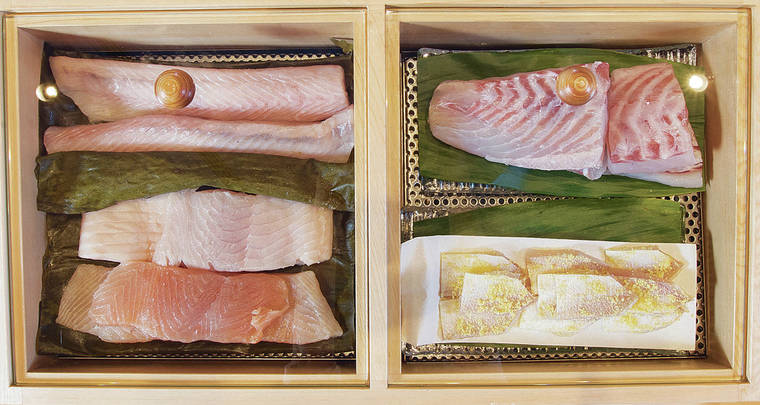Rave Reviews: Lesa Griffith

CINDY ELLEN RUSSELL / 2016
Cured fish is stored in a wooden box at Sushi Sho.
PREMIUM PICK: SUSHI SHO
Ritz-Carlton Residences, 383 Kalaimoku St., Waikiki; 729-9717. Dinner. $$$$
Embedded within the Ritz-Carlton (you have to walk through another restaurant to get to it) is Honolulu’s one truly transformative dining experience. Sushi Sho is a world unto its own, one where Keiji Nakazawa practices sushi alchemy.
In the center of the moodily-lit space is a grand ikebana arrangement atop a pedestal carved from 1,200-year-old Japanese cedar. The sushi counter is like a theater, with an audience of just 10.
Nakazawa, one of Tokyo’s sushi superstars, took up Ritz-Carlton’s invitation to open a restaurant because he felt he had hit a ceiling. He wanted to move to Hawaii to explore new kinds of fish and ingredients.
So along with offering seasonal delicacies from Japanese waters, such as shira-ebi (baby shrimp), he also works with moi, fermenting it in a cedar box with rice seasoned with red vinegar. In fact, aging and preserving fish are top skills when it comes to edomae-style sushi. If you think sushi is basically sashimi on rice, the deep, intense flavors of Nakazawa’s preserved tuna will open up a whole new world of possibilities.
Don't miss out on what's happening!
Stay in touch with breaking news, as it happens, conveniently in your email inbox. It's FREE!
Small prepared dishes are delightfully innovative, such as his take on laulau — a bite-sized cube of opah cheek and salmon wrapped in a band of luau leaf and sitting in a pea-green asparagus puree.
Dinner here is omakase all the way — sit down and food starts coming, all 32 courses. The evening costs $300, and it is worth every bite. And plan to order sake — Nakazawa is also a sake sommelier, so his selections are impeccable.
And if you don’t trust my taste, how about Senia chef Chris Kajioka? He says this is the best restaurant in the city.
TANE VEGAN IZAKAYA
2065 S. Beretania St., Moilili; 888-7678. Dinner. $$
Two McKinley High School dropouts — Kin Lui and Ray Wang — made it big in San Francisco with a brace of Japanese restaurants that include the sustainably sourced sushi restaurant Tataki and Shizen, a vegan izakaya and sushi spot.
They reproduced the concept in the space that was Sushi Izakaya Shinn, and it has been a hit since Day One.
Lui and Wang have created a new cuisine language. Rather than trying to imitate fish, as Western vegan restaurants do with meat, Tane simply highlights vegetables, fruits and nuts to create flavor and textural combinations — on rice — like you have never tasted before.
Be sure to try the specialty rolls — the Manila Dune is an Instagram-ready construction of pumpkin tempura, spiced gobo, shredded tofu, avocado crema and chili, topped with little fans of lotus chips. Along with classics like goma-ae (steamed spinach) and agedashi tofu, small-plate bites can be creative surprises such as shiitakes stuffed with shredded tofu and matcha salt.
If you must eat gluten-free, you’ll be happy to know that temari is the only shoyu used here, and the surprisingly flavorful ramen broths can be ordered with gluten-free noodles.
RESTAURANT DO-NE
1614 Kalakaua Ave.; 626-5782. Lunch, dinner. $$
Popular mom-and-pop holes in the wall score high on the cheap and cheerful factor. But it’s rare to find a spot that is cheap, cheerful and delivers truly good food.
Six-table Do-ne, on the edge of Waikiki, is easy to pass by, except for the cluster of devoted customers (a lot of them nihonjin) waiting out front. This simple box is where Masanori Ogi, a former chef and manager of Menchanko- Tei in Waikiki, and his wife, Hitomi, have been sending out everyday Japanese dishes prepared with quality ingredients, real skill, and, yes, love, since 2013.
There are pupu (sliced tako with wasabi, monkfish liver in a lively ponzu) and salads (daikon and shiso, pork shabu shabu) to round out your meal, but the focus is on the dinner sets — things like the marinated fried chicken (Ogi is from Kyushu and this is a regional specialty), grilled hokke (a type of mackerel) and salmon-and-ikura don come with three kobachi (mini side dishes), such as a single shrimp on a curlicue of soba topped with two soybeans), along with a flavorful miso soup (so often barely more than chalky hot water at comparable spots), pickles and perfectly cooked rice — no dried-up starch here. All for an average $14.
Do-ne is also BYOB, and budget hunters come in with coolers, lingering over Heinies or sake while they pick at pupu like fried gizzards and tamago. The Ogis don’t mind — they are not in it to squeeze dollars out of you. They just want to feed you honest food, and the calm, attentive server only adds to the warm-and-fuzzy atmosphere.
They even have the courtesy of listing not only daily and weekly specials, but the specials for the following week, so you can plan accordingly. Do-ne means “how you doing?” in Kyushu slang, and after a visit here, your answer will inevitably be, “just fine.”
Lesa Griffith is a Honolulu-based freelance food writer.






